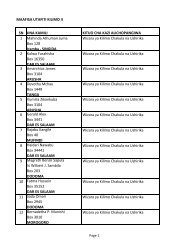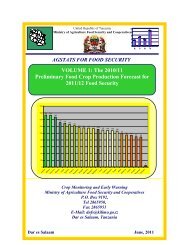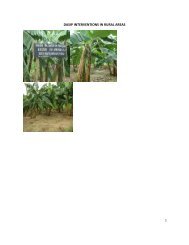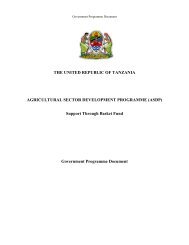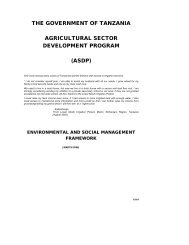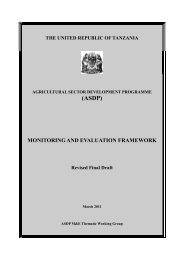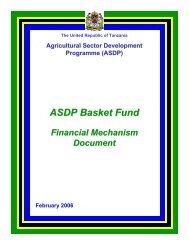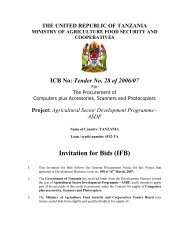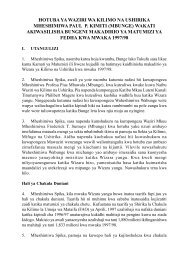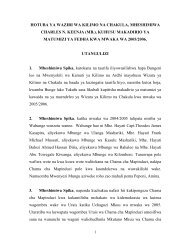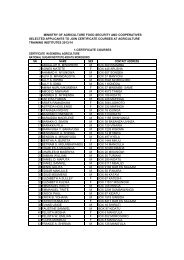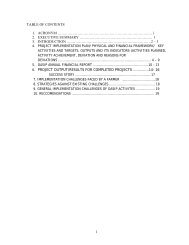Large Scale Farm Report - Ministry Of Agriculture, Food and ...
Large Scale Farm Report - Ministry Of Agriculture, Food and ...
Large Scale Farm Report - Ministry Of Agriculture, Food and ...
Create successful ePaper yourself
Turn your PDF publications into a flip-book with our unique Google optimized e-Paper software.
REGIONAL PROFILES68obtaining irrigation water. Tanga has the third largest number of farm implements <strong>and</strong> assets, mostly comprising oftractors, harrows <strong>and</strong> ploughs.A relatively high number of large scale farms receive extension services, mainly provided by the Government. Very fewfarms borrowed money for agricultural purposes from credit facilities. Tanga has a fourth largest number of trees plantedon large scale farms (332,427 trees).The number of farms keeping livestock is moderate (ninth largest region) with 37 large scale farms. It has the sixth largestnumber of cattle (most of them indigenous) producing a moderate quantity of milk per day. It has a moderate number ofgoats <strong>and</strong> sheep <strong>and</strong> the number of pigs is small. Also, Tanga has the moderate number of chickens compared to otherregion <strong>and</strong> most of them are improved.Tanga region has a few farms receiving livestock extension services compared to some of the regions. Also it has thehighest number of farm employees, both permanent <strong>and</strong> temporary employees. The number of male employees is higherthan female employees.4.3 KilimanjaroKilimanjaro region has 96 large scale farms with a l<strong>and</strong> area totaling 25,195 hectares under crop production on large scalefarms <strong>and</strong> has a relatively high number of crop growing large scale farms compared to other regions. Few of them havelivestock. The region has a moderate l<strong>and</strong> area per crop growing farm of 876 ha <strong>and</strong> almost all available l<strong>and</strong> is utilized.The region has short <strong>and</strong> long rainy seasons with the long rainy season being slightly more important. Kilimanjaro hasalmost equal importance of annual <strong>and</strong> permanent crops, some of which are in mono-crop st<strong>and</strong>s <strong>and</strong> the remainder inmixed annual/permanent crop.Cereal production in Kilimanjaro is important especially for maize, wheat <strong>and</strong> barley. The region has the largest area ofl<strong>and</strong> planted with Irish Potatoes compared to other regions. Paddy, sorghum, cassava <strong>and</strong> groundnuts are almost absent onlarge scale farms in the region. There is a moderate to low cultivation of beans <strong>and</strong> vegetables. The region has the secondlargest planted area of sugar cane <strong>and</strong> third for coffee <strong>and</strong> banana. Small amounts of oranges <strong>and</strong> mango are also grown inthe region.Kilimanjaro has the largest planted area with irrigation in Tanzania <strong>and</strong> has the second largest number of farms irrigating.Rivers are the most common source of irrigation water <strong>and</strong> the region has the highest percent of farms using canals.Practically all irrigation water is obtained by gravity <strong>and</strong> few farms use motor pumps. Similarly, flood irrigation in theregion is the second highest in the country. Pipes <strong>and</strong> sprinklers are also commonly used with very few farms applyingirrigation water by linear boom, horse reel sprinklers <strong>and</strong> drip irrigation.Kilimanjaro has the fourth highest number of farm implements in the country. It has the fourth largest number of tractors,fifth largest number of harvesters <strong>and</strong> third largest number of ploughs <strong>and</strong> harrows. Kilimanjaro is among the regionshaving the highest number <strong>and</strong> percent of large scale farms receiving extension advice in the country, Government beingthe main extension provider.Tanzania <strong>Agriculture</strong> Sample Census – 2003



